What is the cause of the child's arrhythmia?

|
Everyone knows that heartbeat is regular. When many people hear that a child has an irregular heartbeat, they think it is an abnormal phenomenon. In fact, a child's irregular heartbeat is a normal physiological phenomenon. But what is going on with the child’s arrhythmia? This is a question that many parents want to know. Let’s learn about it together. I hope it can help more people. What causes arrhythmia in children? 1. Respiratory sinus arrhythmia: Respiratory sinus arrhythmia is the most common type of sinus arrhythmia. It mostly occurs in children, young people and the elderly, and is less common in middle-aged people. The mechanism of respiratory sinus arrhythmia is that during the breathing process, the tension of the vagus nerve and sympathetic nerve in the body changes, causing the automaticity of the sinoatrial node to change periodically and regularly. When you inhale, the sympathetic nerve tone increases and the heart rate increases. When you exhale, the vagus nerve tone increases and the heart rate slows down. The cycle of changes in heart rate is exactly equal to one breathing cycle, and the heart rhythm becomes regular when breathing stops. The electrocardiogram features are as follows: ①The P wave is the "sinus P wave" emitted by the sinoatrial node (positive in leads Ⅰ and Ⅱ, negative in lead aVR), and its shape is constant. ② The speed of the heart rate changes with breathing. The heart rate increases when inhaling and slows down when exhaling. The cycle of its speed change is exactly equal to one breathing cycle. ③ In the same lead, the difference in RR interval or PP interval is more than 0.12 seconds. ④PR interval is greater than 0.12 seconds. 2. Non-respiratory sinus arrhythmia: Non-respiratory sinus arrhythmia is less common and the specific cause is not very clear. Some people believe that it is related to anger, emotional instability, or the use of certain drugs (such as digitalis, morphine, etc.). The electrocardiogram features are as follows: ①The P wave is the "sinus P wave" emitted by the sinoatrial node (positive in leads Ⅰ and Ⅱ, negative in lead aVR), and its shape is relatively constant. ② Changes in P wave frequency have nothing to do with breathing, and the heart rate sometimes suddenly increases. ③ In the same lead, the difference in PP interval or RR interval is more than 0.12 seconds. ④PR interval is greater than 0.12 seconds. 3. Wandering rhythm in the sinoatrial node: The point of excitement moves within the sinoatrial node, so the shape, size and direction of the P wave on the electrocardiogram gradually change. The electrocardiogram characteristics are as follows: ①The P wave is a sinus P wave (positive in leads Ⅰ and Ⅱ, negative in lead aVR). ②The shape and size of the P wave are inconsistent. ③The PR interval varies in length, but is always longer than 0.12 seconds. 4. Sinus arrhythmia related to ventricular contraction and blood discharge: Sinus arrhythmia related to ventricular contraction and blood ejection is caused by abnormal ventricular contraction and blood ejection, which leads to uneven blood supply to the sinus node, thereby causing changes in the autonomy of the sinus node. 5. Sinus arrhythmia induced by ectopic rhythm: Ectopic excitation, especially that originating from the atrium, can sometimes cause the excitation of the sinoatrial node to occur prematurely, followed by inhibition of the sinoatrial node, thus causing sinus arrhythmia induced by transient ectopic excitation. Respiratory arrhythmia, caused by the expansion and contraction of the chest cavity during breathing, is common in children and young people. It usually has no pathological significance and does not require treatment. It is also seen in heart patients. Sinus arrhythmia that is not related to breathing is more common in the elderly and patients with heart disease. It is completely normal for children to have an irregular heartbeat, and almost every child will experience it. As a parent, there is no need to worry, and no treatment is needed. Children can study and live normally. This situation is also beneficial to enhance the child's heart function. For more knowledge, you can follow the editor at any time. The editor will continue to contribute sincerely to everyone. |
<<: Causes of recurrent tonsillitis in children
>>: What to do if your child has contact dermatitis
Recommend
What is the reason for the baby's earwax to smell?
Nowadays, people’s living environment is relative...
Child sweating and coughing while sleeping
In daily life, many babies are prone to sweating ...
Taboos for eczema on the face of a one-month-old baby
After a child is born, its skin is not yet fully ...
Can babies with roseola be blown dry?
Parents are very protective of their infants and ...
What are the dangers of obesity to children?
As the living standards continue to improve, peop...
What to eat for children with acute rash
When it comes to children with roseola, parents m...
Which department should I go to for my child's lumbar pain?
Children are the treasures of their parents. Inco...
How many times does a two-month-old baby poop?
When taking care of a baby over two months old, i...
What are the symptoms of hydronephrosis in children?
Hydronephrosis in children is also a common kidne...
What to do if your baby has a fever after vaccination
It is normal for babies to get vaccinations. Babi...
Treatment for children's nighttime crying
Children's crying at night often makes our pa...
How to make baby's hair grow thicker? These eight points must be followed!
If you find that your baby's hair is obviousl...
What is hydronephrosis in infants?
Infant hydronephrosis is a common disease in the ...
What should I do if my baby has a stuffy nose and can’t sleep well? 3 solutions
If the baby has nasal congestion when sleeping at...
How many days will a child's mycoplasma fever last?
It is said that mycoplasma is the simplest prokar...









